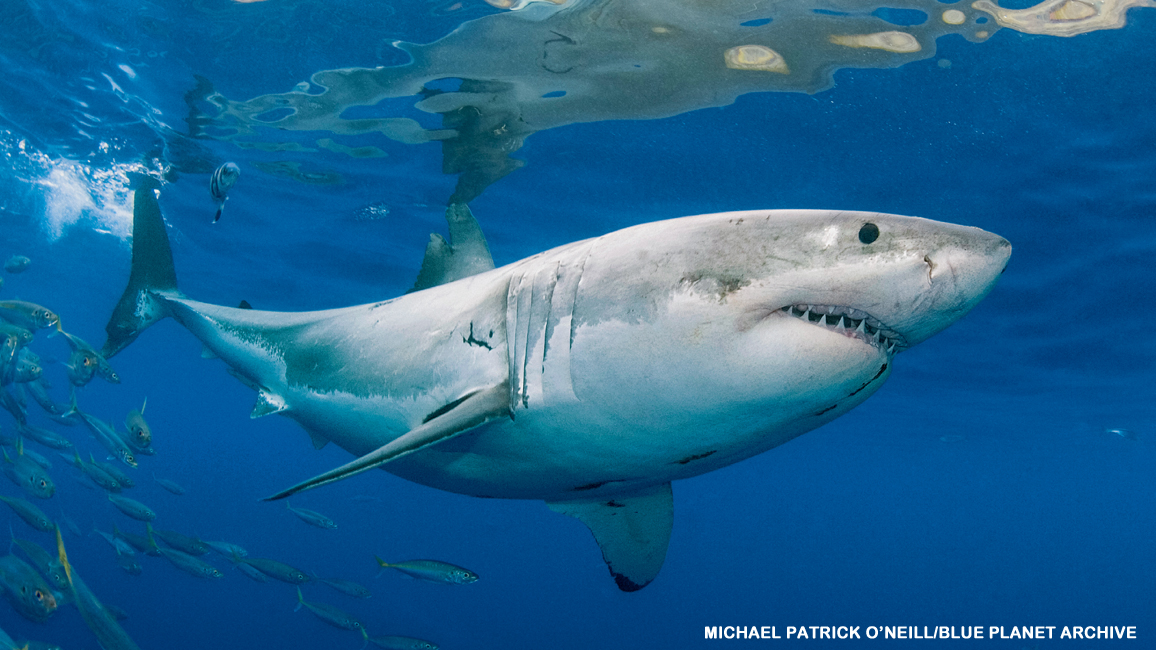
Great White Sharks
By Kathy KrankingSure, they’re big. And, yes, they’re toothy. But there’s a lot more to know about . . .

Whoa—check out this amazing great white shark as it cruises by. The biggest great whites are longer than a full-sized car and about as heavy. A great white is no guppy!
Great white sharks live in cool coastal waters around the world. Like other sharks, they have no bones. Instead, their skeletons are made of cartilage (KAR-tuh-lihj), the stiff but bendy stuff in your nose. (But don’t try to bend a great white’s nose!)
Books and movies haven’t been kind to great white sharks. They’ve made them out to be bloodthirsty, man-eating monsters. But are they really? Read on to learn more about them . . . and you can decide for yourself.

Shark Sense
From the tip of its nose to the tip of its tail, a great white shark is built to survive. It has everything it needs to be one of the ocean’s top predators. For one thing, a great white has awesome senses. It relies on them for—well, just about everything.
Take its sense of smell. A great white’s nose is a super sniffer. Its nostrils are on the underside of its snout. And, unlike your nostrils, sniffing is their only job. (Sharks breathe using their gills, not their nostrils.) A great white can sniff out one drop of blood in 10 billion drops of water. That’s a nose that knows!
A great white shark also has great hearing and eyesight. Its ears are tiny openings on the sides of its head. They let the shark hear everything a human can hear, and even sounds a human can’t. Its eyes can see well in light or darkness. And when a great white attacks prey, it has a cool trick: It rolls its eyeballs back into its head to protect them from harm!
Secret Weapons
A great white has a couple of special, “high tech” ways of sensing things. One is a row of tiny sensors along each side of its body. This lateral line lets the shark detect nearby movements or vibrations in the water. So it can feel things, such as nearby prey, without touching them.
A great white has different sensors on its snout. These tiny openings can sense electricity in the water. Since all living things give off bits of electricity, the shark can use the sensors to zero in on predators, prey, or even mates.

Champion Chompers
Of course, you can’t talk about the great white shark without talking about those famous teeth! A great white has 300 of them. They are about 2 inches long and are razor sharp. Sometimes the teeth can break, fall out, or get worn down. But no worries: The shark has extra teeth that move up to replace them.
As a top predator, a great white’s only natural enemies are orcas (killer whales) and other great whites. An adult great white preys mostly on sea mammals, and its favorite meals are seals and sea lions. But it will also prey on other creatures, such as sea turtles and fish, including other sharks.
One thing not on the great white shark’s menu is people. People are not the natural prey of a great white. Great whites do sometimes attack humans. But these attacks are rare and usually
happen because the sharks mistake people for prey. A person paddling along on a surfboard, for example, can look like a seal or sea lion from below to a great white.
The truth is, great whites have much more to fear from humans than humans have to fear from great whites. People hunt these sharks for their meat, skin, fins, and teeth, and also as trophies in sport fishing. Great whites can get caught in fishing line and netting. They’re also harmed by pollution caused by people. In some areas, there are fewer than half as many great whites as there once were.
But people are working hard to help great whites. They’re passing laws to protect them. And scientists are studying them to learn more about their behavior. One way is by putting special tags on them. The tags send signals that scientists use to track the sharks’ movements. Then people can find ways to protect them in the areas where they’re found.
The hope is that, with some help from people, these amazing sharks will be cruising their way through the ocean forever.
















